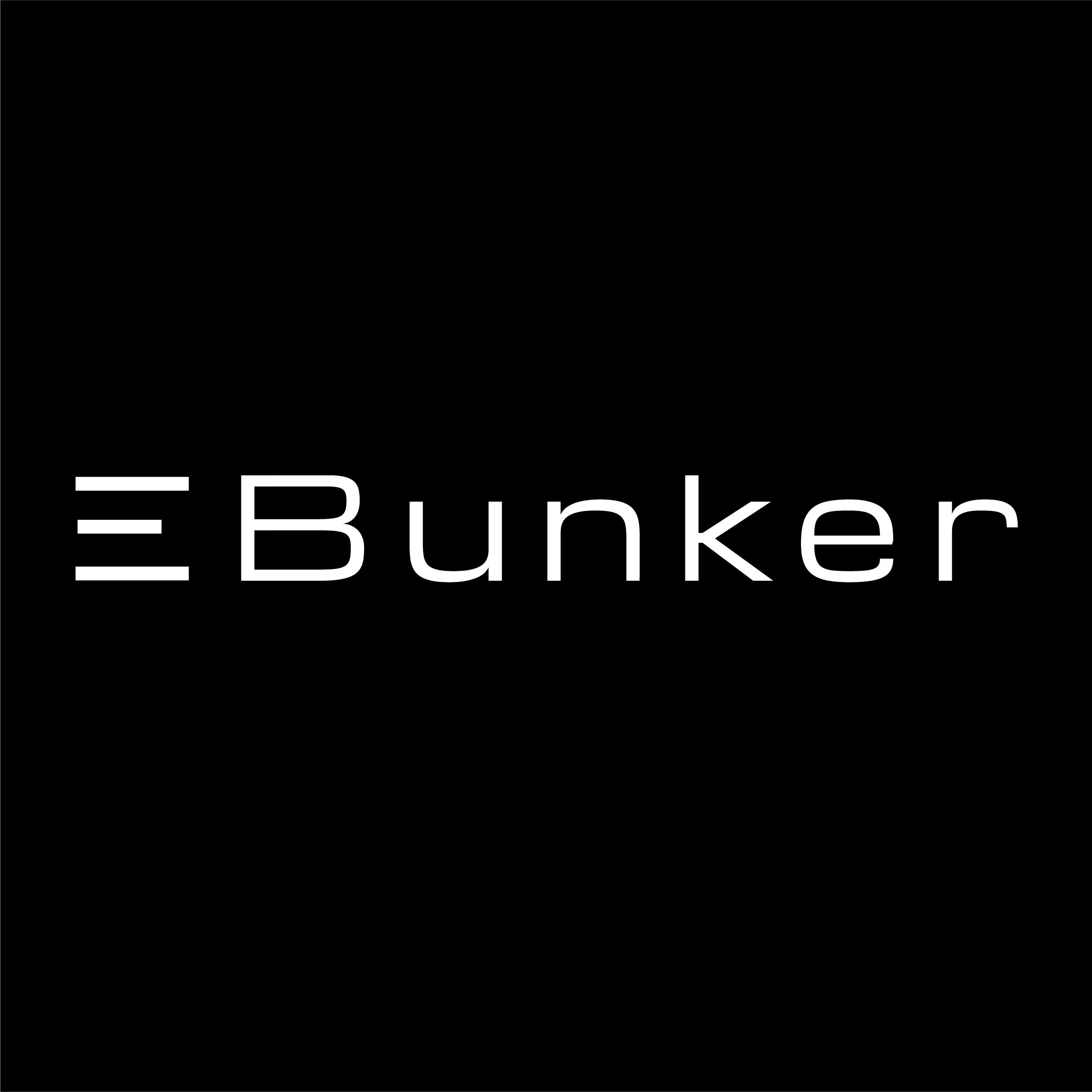The concept of modular blockchain
Modular blockchains are blockchains that focus on handling a few responsibilities and outsource the rest to one or more independent layers. Modular blockchain can be used to handle the following individual tasks or a combination of tasks:
Execution: Supports the execution of transactions and enables deployment and interaction with smart contracts.
Data availability: Ensure the availability of transaction data.
Consensus: The content and sequence of approved transactions.
Settlement: Used to complete transactions, resolve disputes, verify proofs, and bridge different execution layers.
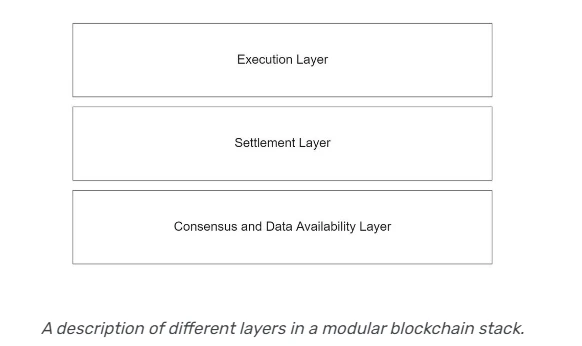
Modular chains typically perform two or more interdependent functions. For example, the data availability layer must agree on the ordering of the data, otherwise it is impossible to know which data represents the correct version of the history.
Advantages of Modular Blockchain Design
Scalability:Using modularity in blockchain can increase scale without introducing harmful trust assumptions.
Easy to launch new blockchain:By leveraging a modular design, new blockchains can be launched faster without having to worry about getting every aspect of the architecture correct.
flexibility:Purpose-built modular chains provide more options for trade-offs and design implementations. For example, a modular blockchain system might include modular chains that focus on security and data availability, while others focus on execution.
Disadvantages of modular blockchain design
safety:Unlike monolithic chains, modular blockchains cannot guarantee their own security quality. Modular blockchains are at risk of failure if the security layers used to handle consensus and data availability are ineffective.
Complexity:Implementing a modular blockchain design introduces new complexities. For example, Ethereums data sharding plan relies on data availability sampling to ensure that nodes on a certain shard are not hiding data. Likewise, the execution layer must create certain complex mechanisms, such as fraud proofs and validity proofs, so that the security layer can guarantee the validity of off-chain state transitions.
Token value:Some modular blockchain native tokens may not be able to absorb value due to limited applications. For example, utility tokens that focus solely on the consensus and data availability layers have less use than the execution layer, so it may also be more difficult to attract participants to such a network.
Ethereum’s modular form: sharding and rollup
Like first-generation blockchains such as Bitcoin, Ethereum was originally designed as a monolithic blockchain. However, in order to enhance network performance, improve scalability and sustainability, the Ethereum network is currently transitioning to a modular framework.
Sharding is the process of dividing a system (such as a database) into multiple parts to run. By distributing functionality across multiple components, the system can achieve greater output and efficiency. In a blockchain network, sharding divides the blockchain into multiple sub-chains, and the sub-chains handle different parts of the network activities.
In Ethereum’s sharding design, 64 shard chains will run in parallel. Sharding can process transactions in parallel (execution sharding) and can also be used to store different parts of blockchain data (data sharding). With data sharding, Ethereum nodes will only store data published on their shard chain — as opposed to the current structure, which requires all nodes to store the same data.
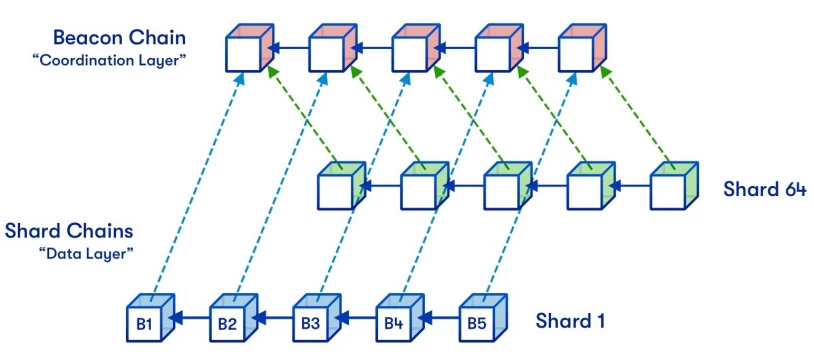
The relationship between Ethereum’s beacon chain and shard chain
Sharding is a form of modularity where different components (shard chains) handle different responsibilities. In data sharding, shard chains store different parts of Ethereum data, and execution sharding allows each shard chain to process its own set of transactions, increasing data throughput and reducing processing time.
Some developers have adopted a rollup-centric approach to scaling Ethereum. Unlike purely off-chain scaling solutions (such as sidechains), rollup is tightly integrated with the main chain. The Ethereum blockchain outsources computation to rollups while preserving settlement, consensus, and data availability. Since Ethereum serves as the base layer for L2 rollups, rollups can actively optimize execution through faster block times and larger blocks without compromising decentralization or security.
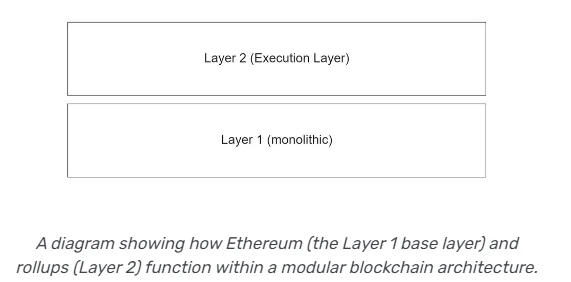
The functions of Ethereum (L1 base layer) and rollup (L2) in modular blockchain architecture
Ethereum’s modular technology stack development process
The development process of Ethereum’s modular technology stack is as follows:
1. Monolithic blockchain: Represents Ethereum L1 or main chain, which itself is a monolithic blockchain.
2. Rollup: L2 solutions that act as the execution layer, such as Arbitrum and Optimism, move the execution layer out of Ethereum L1, publish state roots and rollup data and transmit it back to Ethereum L1.
3. Modular rollup: rollup with modular data availability.
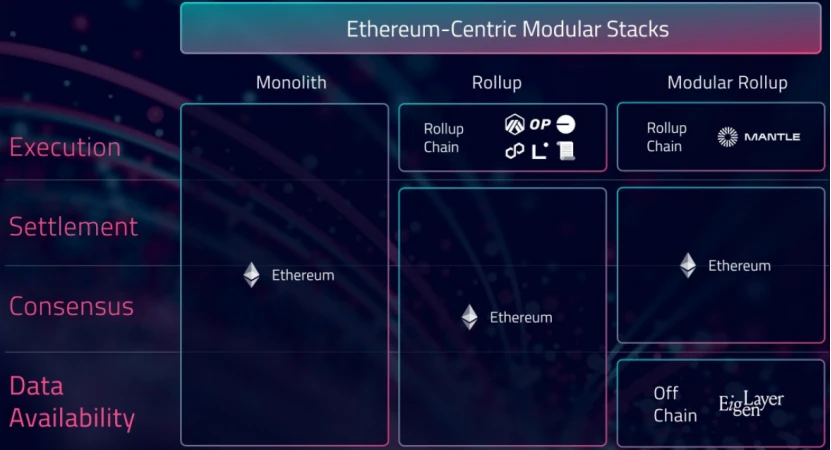
Ethereum’s modular L2 technology stack can provide scalability while retaining high levels of security and decentralization. This powerful combination provides Ethereum with the foundation for a more efficient and sustainable blockchain ecosystem.
Monolithic Blockchain
The monolithic blockchain is the original running form of Ethereum and handles everything without the use of rollups or data sharding. This monolithic architecture provides the highest security, but comes at the cost of high cost and limited scalability. Therefore, the transaction speed of the Ethereum mainnet is relatively slow, with an average TPS of only 15 – 20. Currently, Ethereum is gradually transforming into a modular blockchain, mainly through the adoption of rollup-centric computing and data sharding strategies.
Rollup
Rollup is the earliest technological breakthrough in modular blockchains, extending Ethereum’s monolithic architecture by providing a separate layer for execution. Rollup securely abstracts the execution layer of the blockchain into a sequencer, which uses powerful computers to package and execute multiple transactions before regularly transmitting compressed data back to the Ethereum mainnet for verification. Rollup can increase TPS by 20 – 50 times by moving this calculation process off the Ethereum chain.
In the current scenario, rollup plays the role of the execution layer, processing transactions while outsourcing settlement, consensus, and data availability. For example, optimistic rollup using Optimistic virtual machines and ZK rollup running zk EVM. These rollups execute smart contracts and process transactions, but still rely on Ethereum to:
Settlement: All rollup transactions are completed on Ethereum. Optimistic rollup users need to wait until the challenge period passes, or until the transaction is deemed valid after fraud prevention calculations. zk rollup users need to wait until validation validity is proven.
Consensus and data availability: rollup publishes transaction data to the Ethereum mainnet in the form of CallData, allowing anyone to perform rollup transactions and reconstruct their state if needed. Optimistic rollups require a large amount of block space and a 7 – 14 day challenge period before finality. Zk rollup stores data available for verification for 30 days, providing instant finality but requiring significant processing power to create the proof.
With Ethereum as the base layer for rollups, rollups can allow for faster block times and larger blocks without compromising decentralization or security. Rollup can be said to be the beginning of a new era for Ethereum. The total transactions of Arbitrum and Optimism have recently exceeded the number of transactions on Ethereum, reflecting Ethereum’s modular trend.
Modular rollup
Newer modular rollups move the data availability layer out of Ethereum. Mantle, for example, still relies on Ethereum for settlement and consensus, but leverages Mantle DA as a data availability layer. Mantle DA performs data sorting and provides data certification without executing transactions; executing transactions is effectively outsourced to Mantle’s execution layer.
Previously, Ethereum was the only data availability solution for rollups, leading to cost challenges. Data availability is the largest source of cost for most rollups, especially storing transaction data on Ethereum, which can account for up to 70% of the cost. Moreover, this cost is variable and increases proportionally to usage, posing a significant barrier as more users join. Until now, only large rollups with significant resources could accommodate larger user bases.
Thankfully, things are changing on Ethereum, and new modular solutions are emerging in the form of data availability layers to reduce transaction data submission costs. Major examples of data availability layers include EigenDA, Celestia, and Avail, which all address data availability issues and provide potential solutions to the limitations of rollup.
A modular future
Over the past decade or so, the blockchain field has often fallen into a vicious cycle when dealing with scalability challenges—continuously creating new L1 blockchains due to the high costs and limitations of Ethereum. However, Ethereum’s high fees are not actually an unsolvable bug.
In a world where L2 solutions are becoming the norm for mass adoption, modular blockchain revolutionizes blockchain architecture by dividing execution, settlement, consensus and data availability layers. When monolithic blockchains struggle with scalability, the potential of modular architecture will be unleashed.
As the data availability layer evolves and competes, the barriers to entry and barriers to entry for new rollups will be significantly lowered. In the near future, applications on OP or ZK stacks are likely to see a boom due to lower data availability costs and further improvements in modular functionality.
Ebunker official website:https://www.ebunker.io

